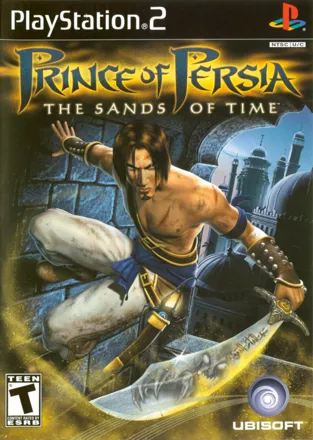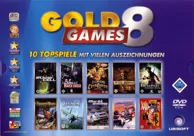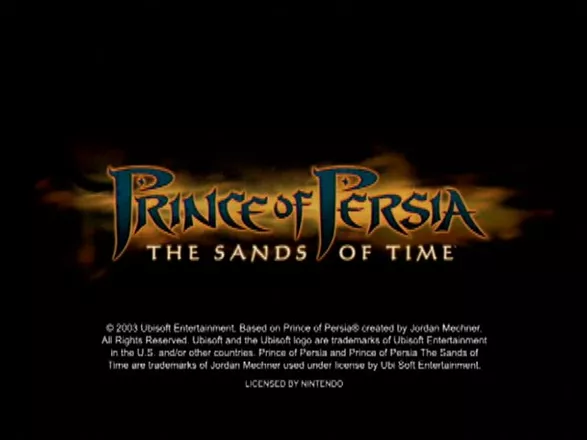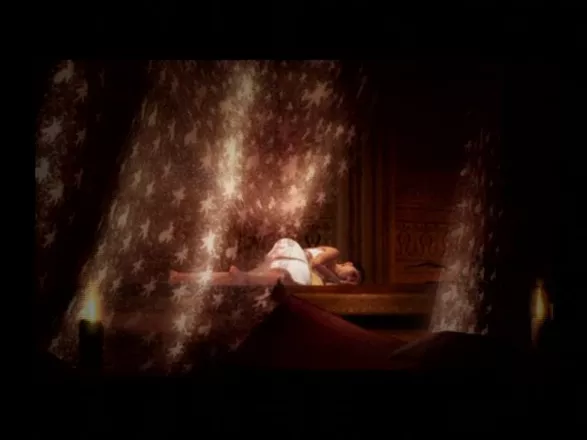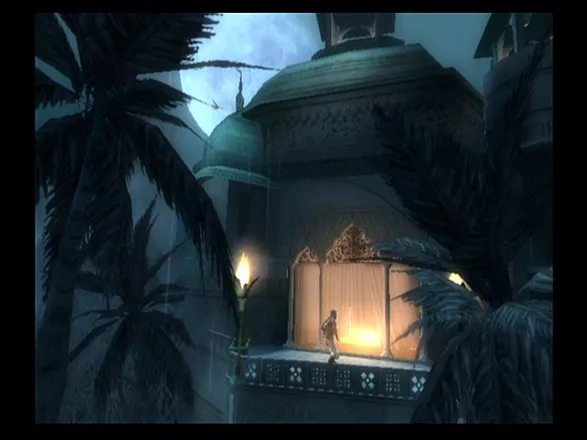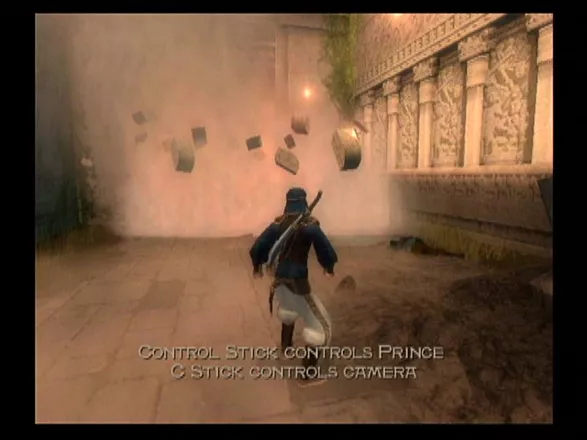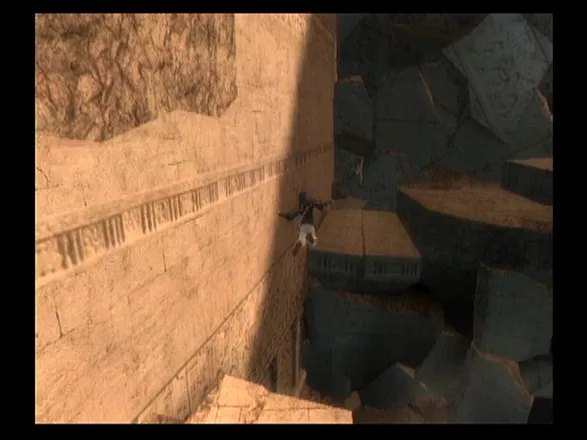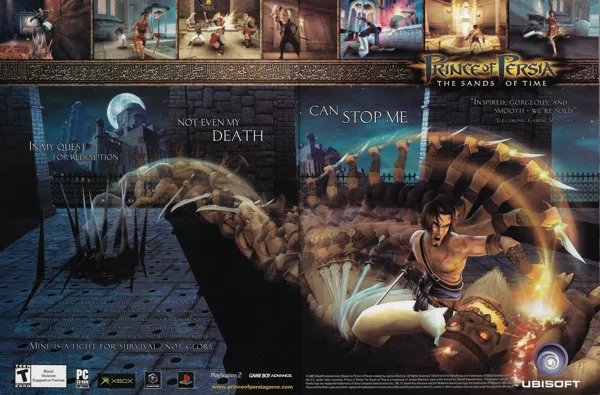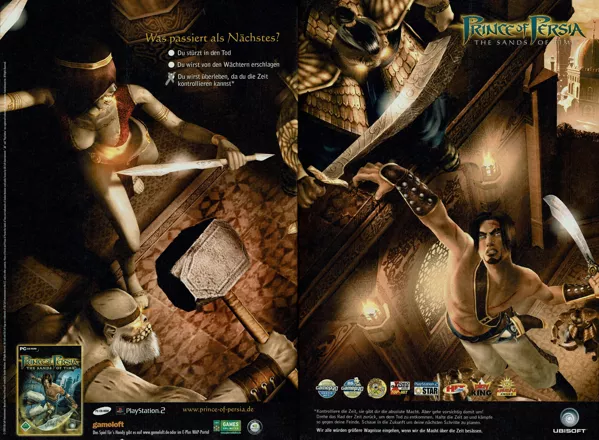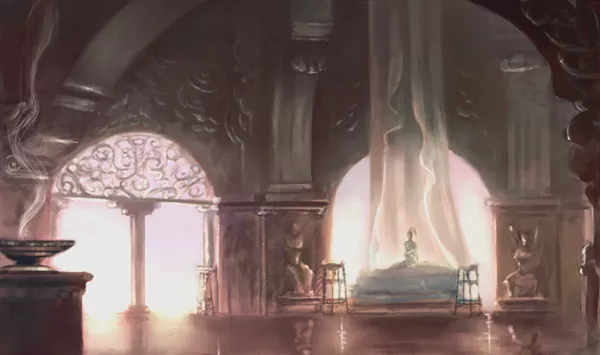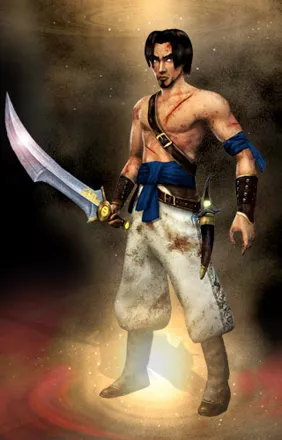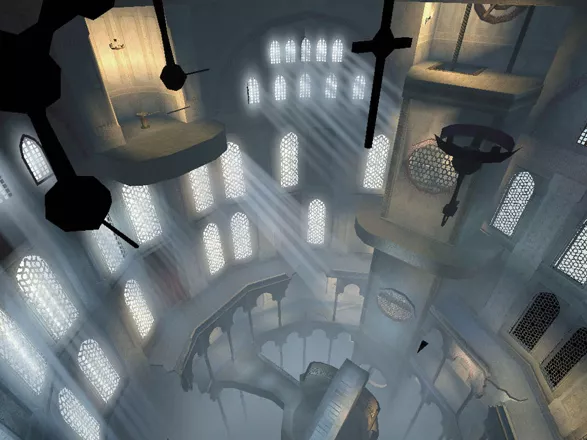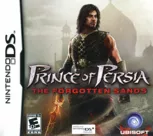Prince of Persia: The Sands of Time
-
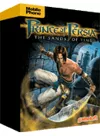 Prince of Persia: The Sands of Time
(2003 on
BREW,
J2ME,
Symbian)
Prince of Persia: The Sands of Time
(2003 on
BREW,
J2ME,
Symbian)
-
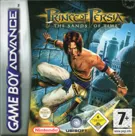 Prince of Persia: The Sands of Time
(2003 on
Game Boy Advance)
Prince of Persia: The Sands of Time
(2003 on
Game Boy Advance)
Description official descriptions
The King and the Prince of Persia are besieging the Maharajah's castle to plunder the treasures hidden inside. In order to impress his father, the Prince sneaks inside to recover the magical Dagger of Time. He quickly learns that this dagger has the ability to control time. The malevolent Vizier has other plans for the dagger, however, and tricks the Prince into unlocking a mysterious secret of the Dagger that causes the King and many of his subjects to be turned into sand zombies. Now, the Prince must figure out what has happened and try to set things right again.
Prince of Persia: The Sands of Time is an action game with platforming and puzzle-solving elements. It updates many of the gameplay concepts from the previous games, and brings them into a fully three-dimensional world. The Prince will engage in sword fighting, wall climbing, spike dodging, puzzle solving, and more in his quest. The Prince also carries the Dagger of Time, which allows him to unleash several magical powers. The most important of these powers is the ability to reverse time. This ability allows the player to reverse their actions when they lead the Prince to his death.
Spellings
- Принц Персии: Пески Времени - Russian spelling
- 波斯王子:时之砂 - Simplified Chinese spelling
- 波斯王子:遺忘之砂 - Traditional Chinese spelling
Groups +
- Covermount: Fullgames
- Covermount: Level (Romania)
- Game Engine: JADE
- Gameplay feature: Time manipulation
- Games made into movies
- Games with hidden / unlockable full games
- Green Pepper releases
- Middleware: Bink Video
- PlayStation 2 Greatest Hits releases
- PlayStation 2 Platinum Range releases
- Prince of Persia series
- Protagonist: Royalty
- Setting: Indian
- Software Pyramide releases
- Theme: Time travel
- Ubisoft eXclusive releases
- Xbox Platinum Hits releases
Screenshots
Promos
Videos
Add Trailer or Gameplay Video +1 point
See any errors or missing info for this game?
You can submit a correction, contribute trivia, add to a game group, add a related site or alternate title.
Credits (PlayStation 2 version)
250 People (223 developers, 27 thanks) · View all
| Producer | |
| Creative Director | |
| Lead Programmer |
|
| Lead Level Designer |
|
| Art Director | |
| Animation Art Director | |
| Art Production Manager | |
| Animation Production Manager | |
| Sound Designer | |
| Writer | |
| Game Designer | |
| Creative Consultant | |
| Associate Producer | |
| Level Design Team | |
| Programing Team |
|
| [ full credits ] | |
Reviews
Critics
Average score: 91% (based on 116 ratings)
Players
Average score: 3.9 out of 5 (based on 257 ratings with 10 reviews)
The Good
As if we needed more proof that nostalgia sells more games than originality, here we have another next-generation revival of a classic game series: Prince of Persia, which everyone must remember from it's glory days of 2D platforming. However for the poor Prince, this isn't his first "resurrection" as he was brought to the brand new world of 3D adventure once before in a title that only brought embarrassment to anyone that came into contact with it. It is thanks to that title that my expectations for "Sands of Time" were pretty low, however Ubisoft proved with this title that they really have a midas touch lately, and thus they developed a game that is nothing short of genius.
Not concerned with following the original game's chronology, the game casts you as yet another "Prince of Persia" who (along with his father) gets tricked into invading a kingdom by an evil Vizier (who else?) in order for him to get his hands into the magical "Sands of Time" held there. The problem for the Vizier comes when our glory-seeking Prince goes beyond the call of duty and takes a dagger that holds the key to the sands as a trophy in the invasion. After a failed attempt by the Vizier to get the dagger, the Prince unleashes the sands by mistake and turns everyone in his castle to some kind of sand-zombies with only himself, the Vizier and a mysterious girl remaining alive. It's up to the Prince and his newly found ally to now make their way through the castle and face the Vizier with the hope to turn everything back to normal.
As expected, the gameplay follows most of the 3D action-adventure rules, you have to jump and run around, crawl through ledges and slash at whatever comes your way. But Ubisoft added an innovative batch of gimmicks and refined the "classic" bits of the genre so as to make it an almost perfect game. The main flow of the game follows the classic design of the series, which has you sorting all sorts of traps and pitfalls through acrobatic stunts. These include jumping around, rolling, mantling, climbing ladders, bouncing off-walls, pole-swinging and in a cool Matrix-inspired addition, even running on walls! Combat uses a simple scheme of two-attack buttons plus a block one, which is easily one of the best combat systems ever implemented (so good in fact, that it became the focus of the sequel: Warrior Within) opponents are auto-locked as expected nowadays (meaning your movement automatically switches to circle-strafing around the closest enemy). As it often happens in these games however, you are easily surrounded by several opponents and anyone who's ever had a fight in these games is surely familiar with the uncomfortable feeling of having to maneuver what's essentially a giant cardboard box that can only strike in one direction and has to line up to every enemy accordingly... Well, not anymore thanks to Sands of Time! Since the game incorporates the ability to direct your attacks by just pressing the direction your desired opponent is in while you strike. This doesn't mean that your Prince jerks back and forth facing each direction you direct him to, but instead means that he actually twists his torso, kneels and leans towards each direction in a completely dynamic manner. If that alone sounds incredible just wait until you see the way the game works around it, as the added fluidity and adaptability of the combat scheme means your opponents can strike you faster and come in bigger numbers. The results are incredibly dynamic battles that for the first time make fighting in these kind of games a true joy, and that's without taking into account the pre-made yet varied and extremely well done animations that makes each blow and parry a different experience or the acrobatic stunts that allow you to vault over your opponents and bounce between them and strike from above, etc. Most impressive of all however, is how the folks at Ubisoft managed to keep it from getting a completely confusing frenzy by carefully judging the timing in the movements, animations and opponents. One can't help but feel that each fight has a distinct... I dunno... "tempo" as if it were music of some kind, with a rhythm of it's own. Just look at the way the prince holds it's stance after performing a strike as if waiting for the right cue for his next action, blocking and countering are even more obvious as you can distinctively feel the constant pauses between each movement. I don't know, maybe I've had too much of the funny smokes, but no other fighting scheme has ever made feel such things, (except for Virtua Fighter, of course).
Anyway, for as amazing as those gimmicks seem, they pale in comparison with the gimmick that initially sold the game, and which is the time-altering powers of the sands of time the Prince wields. Held in your dagger as a collection of sand tanks, you can use them in a variety of ways such as freezing your opponents in time, make you move at blinding speeds (by putting everything but yourself into slow-motion) and of course, reversing time. That's right, the game actually keeps a constant buffer of some kind of up to 10 seconds of playtime which you can always rewind back to should something go wrong. I cannot even begin to describe how much this revolutionizes the classic platformer gameplay, as it effectively kills the frustration of having to re-do entire game areas because you failed in a specific jump or trap or whatever, as you can cheat death by rewinding back to the point where you screwed up and try it again! Don't worry tough, as this feature is carefully managed and doesn't kill every surprise in the game as one might initially think. The level design alone makes sure the game always holds a nice surprise for you, and it's carefully designed layout makes them super-tight experiences which fail to fall to the classic pitfalls of the genre. This I believe, is thanks to the distinctive 2D logic behind them, which one can easily see whenever one activates the "landscape" view in the game which zooms the camera out to show the player the layout of the particular location he's in. This doesn't mean that the game is merely a 2D platformer done in a polygonal engine, but that the game follows the tight spacing rules and design basics that games like the original Prince of Persia pioneered, a concept more games of this ilk should keep in mind whenever they get lost in the pitfalls of their 3D gameworlds. The careful design means that even the few "puzzle-rooms" found in the game are intuitive and straight-forward, and the addition of "visions" that are just hints perfectly integrated into the context of the game help the player deal with the more challenging situations (and introduce story points every now and then).
Finally, the game is polished and pampered beyond belief thanks to Ubisoft's tremendous production values (which alone crowns them as the European equivalent of EA). The graphic design of the game is simply amazing, with a graphic engine that fully exploits the vertex and pixel shading capabilities of today's GPUs. The engine really falls under the Doom 3 category of "shading engines" which exploit lightning tricks, shading effects and assorted stuff instead of concerning itself with pushing more polygons, in fact the models in Sands of Time aren't impressive at all, but due to the impressive bloom and lighting effects you really couldn't care less about it. Noting down all the kickass effects in the game is really pointless as the game is filled with the now popular distortion effects and motion blurring, but for as good as those are one can't help but feel that it's the small details that really steal the show. Just as an example consider that the game includes caustic reflections for the water! Well, it's obviously a texturing trick as an engine that could make real-time caustics would require a SGI machine at the very least, but it's so well made you'll hardly notice it! Also, a hazy blooming effect is applied to the entire screen, giving it a dream-like soft-focus quality (think of movies like Excalibur) that not only fits the game like a glove by helping the game get that "1001 Nights" motif, but also comes in handy as an additional anti-aliaser as another reviewer mentioned. I can go on and on but you can understand the concept by just taking a look at any screenshot and seeing how this game looks like nothing else. What you can't understand by looking at a screenshot is the incredible character animation, which blends motion captured stuff with character studio-like animation to deliver amazingly lifelike animations (a must for the game really, as the original POP is so fondly remembered among other things, by it's character animation). As an animator myself, I often cringe at the animations in most videogames because they often forget about the anticipation, release and reaction that follows each movement, and which more often than not are the things that sells the idea of a credible, organic movement. This concept is not ignored in Sands of Time and the results are some of the most amazing character animations seen in recent days, and makes each of the many acrobatics and movements made in the game a true pleasure to watch. The camera work also deserves praise as one of the best ever made, not only does it find a way to always position itself in non-intrusive positions, but also goes into slow-motion and switches to "dramatic" positions with a remarkable sense of style that the competition to shame (see? This is how you do slow-mo Max Payne!).
To further complement the game, the sound department received the same care and attention than the graphics, with spot-on sfx, stellar voice acting that permeates every aspect of the game (with the Prince recounting his experiences and adding comments whenever you die, for instance, as if he was telling a tale [which is actually what he is doing] and made a mistake or lost his train of thought ["Wait... No, That's not how it happened" :D]). But most impressive of all, the game has a uniquely and extremely well-designed dynamic soundtrack that mingles Arabic and oriental orchestrations using cittaras and similar instruments with well placed guitar riffs and bass lines that move the entire soundscape from moody oriental tunes to a bitching heavy Arabian-rock mix whenever the action heats up. Oh, and lest I forget, the pre-rendered cutscenes that move the story along are simply amazing in it's quality, not to mention very entertaining, including a particular one that has to be among the most erotic cutscenes I've seen in a videogame (meaning erotic in the good sense of the word, tapping into atmosphere and seduction instead of just plain sleaze as most games [including Warrior Within] often do).
This (the cutscenes, not the eroticism!) brings me to the story of the game which is another jewel in this game's crown, telling a wonderfully entertaining story of love and adventure that not only keeps the player hooked to the end (and what an end that is!) but also charms the player with well-defined characters that follow a classic adventure story but which manage to never feel forced or fall "out of character" while they pursue their quest to undo the damage caused by the Sands of Time. And as I said, the ending alone deserves praise for being one of the most fantastic endings I've played in recent memory, a true beauty of simplicity that nonetheless is incredibly smart and charming as it lets the story and characters come full-circle, and which leaves the player with an incredible sense of gratification and delight after playing it. I can obviously see how this can seem as blind praise, as I can't really tell you why the ending is so great, but trust me, it kicks ass.
The Bad
I'm really hard pressed to find any flaws in this game, but if I had to think about it I would say that it can get pretty easy and short. Particularly easy, as fighting can be a no-brainer at times and the final showdown with the Vizier is a joke.
However there is one thing that totally sucks ass and that is that for the PC version of Sands of Time the developers ditched all the extras found in the console versions (and for those of you that don't know, those include full versions of POP1&2 as well as a reworked version of the first level of POP1 made with the Sands of Time 3D engine). This isn't the first time developers pull this kind of shit on us PC users, and quite frankly I'm getting really annoyed at this.
The Bottom Line
A fantastic game of high adventure that blends stellar and innovative gameplay, a fantastically entertaining storyline and enough production values to put most Star Wars games to shame. Prince of Persia is that rare case where the individual parts of the game are executed with incredible care and talent and the end result, thanks to stellar gaming design manages to be even better than the sum of it's parts. It's meager length and challenge can be somewhat puzzling to some players, but that only means you can play it again sooner!
Now all I need to do is find the idiot that is taking revenge on the PCs superior gaming power by cutting down on our supply of extra features when it comes to porting games.
Windows · by Zovni (10502) · 2005
The Good
The best feature about Sands of Time is by far the graphics and the way it has been programmed. Don't believe the recommendations for the game.... all you need is a good graphics card. I ran it on a slow 400 MHz Celeron and it ran at full graphics at full speed. The GeForce4 did all the work.
Great controls, movement/animation, graphics, sound/music, time-rewind, fight moves, fantastic level designs, etc... It must also be said that the way The Sands of Time captured the feel of the original games was very well done.
The addition of the 'dagger of time' adds another element into the game by allowing you to rewind time if something didn't happen as expected. Very cool.
The Bad
At the start of the game you sit and play with a sense of awe. However after 20 levels of repetitive puzzle room -> too long fight sequence -> save point, it starts getting a little tiresome. Then towards the end, the puzzles start picking up their level of difficulty, and things get interesting.... especially once you have to fight without your 'dagger of time' :) Thankfully by th time the fantastic ending comes, you're well back into it. :)
One thing to note is that the porting of this PS2 game to the PC left behind some flaws. There two points in the game I personally got stuck, and it was due to the game responding too fast/slow. The only way past the situations is varying the number of background applications, enabling 'haste' mode, trying different camera angles, and a whole lot of luck. I assume that this wouldn't be an issue on a faster machine.
The Bottom Line
A kick ass action-puzzle game with graphics that will leave you gasping for more. Imagine a sword yielding Persian, with the ability to rewind time if something goes wrong, and the agility of tony hawk, merged all into one.
I thoroughly recommend it.... well worth the expense.
Windows · by Steff (3) · 2004
Such a great game crippled by such a simple flaw
The Good
Once again you take on the role of the Prince of Persia, but instead of forging though foreboding dungeons as then the original classics, he begins the story as a young warrior that's ready to prove himself in battle with a single goal in mind, to win glory by raiding the treasure vault. Risking death traversing the decaying ruins he only finds an odd dagger, but blinded by pride he claims his prize. However, the purpose of the dagger remains unknown to the naive Prince till the Vizier tricks him into unlocking the hourglass vessel that entraps the Sands of Time, turning all within the palace into zombies under its control save three souls, the Prince, the fallen Maharajah's daughter Farah, and the Vizier. Now the Prince must find a way to undo what has been done and somehow the dagger is the key.
The passages through the palace are blocked with fallen walls, puzzling diabolical traps and hoards of sand creatures. While this task may seem daunting to ordinary men, the Prince's blazing speed and agility allow him to not only leap and swing among the ruins, but run across the walls along deep chasms, climb up walls to unreachable ledges and levers, or even leap back and forth between them up to death defying heights. (As a word of warning, he can't climb walls very well when his feet are wet. Once he's out of the water give his feet a moment to dry.) His range of acrobatic skills are crucial to beating the puzzling paths created fallen ruins and clockwork traps set to kill all who pass. Many of the locked doors will begin to close as soon as they open, so he has to be quick and cunning to dodge the spinning and swinging spikes and blades in time. All of this may seem to be to much for one man, but by mastering a few simple actions the Prince can apply the needed move given the situation and direction he's traveling.
Luckily Farah, the one of the few real characters he meets, decides to aid him in his journey to the recover the hourglass, but only after saving her life. Soon the Prince realizes that her intelligence and petite figure are invaluable to beating many of the puzzles. However, the secrets she hides leads to distrust as well.
Traps are not the only thing that test the Prince. The former inhabitants of the palace have be transformed by the sands into creatures of the undead, forced to do its biding. Luckily the Prince can quickly block and attack in any direction and even leap over to into his attackers. Some of the sand creature may seem single minded, but the undead warriors are also swift and can block many of he moves. Even tough their attacks are usually predictable they can rematerialize anywhere at any time, so he must be cautious or they can easily entrap him. Luckily, Farah will ad you in many of the battles with her lightning fast bow, and mysteriously endless supply of arrows. However, since she doesn't carry a sword and her arrows are too weak to take down some the larger brutes, she can easily be overwhelmed in the later battles, so be careful since he cannot complete the journey to the tower alone.
Even with all of their their might and cunning, they cannot defeat the undead without releasing the sands from their deformed bodies. Soon the Prince learns that the dagger can also be used to weld the Sands of Time to his command, by reversing the flow of time to undo a recent mistake, to slow time to slip though a tough situation, or to release the sands from his foes. Most importantly the dagger can be used to retrieve the sand that is released, which is required for it to preform its time bending magic.
Unfortunately, the sand creatures often guard the sand vortex, the place where the Prince can return if he were to fail at any point, so if he cannot complete the journey to the next vortex he must return to the previous one. Fortunately, if he doesn't gave up, he can often return to a closer point. Since the other points are not typically marked, it can be hard to know where they will be.
Behind the magic of the story and the gameplay, the graphics overall are stunning. The level of detail of the characters and world isn't the greatest, but they strike a fare balance and are well done. While most action games that allow jumping and climbing ledges require a simplified world geometry, and Sands of Time (SoT) still maintains a fairly complex and nearly continuous world. While there are a good number of moving objects in the world, most of it however is static, many of the objects are simple doors and traps.
Atop all of this are detailed textures and soft lighting, which mostly make up for the simple underlying geometry. In fact the texturing of the models doesn't fall far behind those used in to scarce prerendered cutscenes. The world textures are also fairly detailed, but tend to be in monochromatic browns. However, when the world is mostly made of sand and sandstone, there really isn't much one can do. However the lighting does make up for some of the lack of color of the textures, especially in the indoor scenes such as the well. Also the shading and lighting used give it a nice soft somewhat cartoonish feel. After, this is no ultra realistic gore-fest like Doom 3. It's also in the little details where the game really shines. No, I mean literally. The Sands of Time really glow as they float like a soft fog over the floors of the rooms and halls and the dagger even glows in response whenever the Prince wonders near.
One of the elements that would have really ruined the game is animation, but SoT doesn't disappoint. The animation of the Prince is extremely fluid throughout all of the many moves he can preform. He smoothly follows through from one to another with out pausing and it seams that most actions can be interrupted if appropriate to do so. The animation of the other models doesn't fall far behind. One thing that seamed to be missing was facial animation during the game. The Prince's face doesn't seem to move at all when he speaks. At least the in game rendered cutscenes are better. Last, but not least the cloth animation was great. The wall banners fold, shift, and waft as the Prince touches against them or as he pushes them out of the way as runs along the wall behind them. Too bad that's about the only time you really get to see it in action.
The sound and voice overs in the game are great. The sounds are of good quality and the acting is simply top notch. The music in general was great, but I think that it would have been better with they didn't stray so much away from arabic motif with the electric guitar. I know they were going for a harder modern sound, but I would prefer that they didn't.
The Bad
First and for most, the one thing that completely ruined the game for me was the character control scheme. I've played a good number of PC adventure and action games and of the two kinds of control schemes commonly used, character and camera relative, the use of camera relative movement in SoT was by far one of the worst decisions I've seen in a long time. This isn't necessarily a bad thing for an action game, but SoT had to take it one step farther with dynamic camera movement. While sometimes being cinematographically eye catching, in others it becomes painfully clear why every other 3D 3rd person action game I've ever played almost always used character relative controls. I tried in vain to find any way to fix this simple mistake, but alas the option was nowhere to be found.
Most of the time you can at least control the camera to do whatever you wish, but often times it decides to reposition itself on it's own accord and occasionally refuses to move regardless of how bad the angle is. Typical case in point, the prince is on a ledge with the camera pointing let's say north and to the east you can see a pole and a hole in the facing wall the he has to swing to. Now the camera at this point might own its own either decide to swing around to the west so that you can't see the obstacles ahead or swing slightly to the west just enough at last moment so that instead of dashing across the wall toward the pole, continuing to push the right control button will send him climbing up the wall matrix style. Again when as soon as you make it up to the hole, camera swings around behind you to point east, showing you what lays beyond, but the shortly after you push the up button to run inside the camera will suddenly position itself on the other side pointing west. If you're not fast enough to stop or push down instead to account for the abrupt change in camera angle, the prince will spin around to match the new camera angle and run back out the hole again. Having to constantly readjust your prospective of how the controls move the prince through a hall when dodging traps is annoying, but having to do it constantly during battles is just ridiculous. A number of times when I tried to vault over a lesser sand creature to get out a sticky situation the camera would swing around enough that at the last moment that the up button when send the price vaulting over a staff man instead, which would in turn readily fling the prince to the ground with an overhead swing. Also in a few occasions the camera would get stuck with a section of wall or curtain between it and the prince such the view of the prince and his assailants was complete obscured.
My only other real complaint is about the save game points. I know that its a common, and antiquated, crutch commonly used in console games, yet it's a point that's often overlooked when porting games to the PC. At least they manged to integrate the logic of the save game point into the game better than most games I've played recently and even give you a bonus by showing you the path ahead.
The Bottom Line
I really wanted to like the game and often found this unique pole and sword swinging action/adventure to be a real blast, until I found myself caught between a battle with hoards of sand creatures and the constant disorientation induced by a runaway camera with a mind of it own. It's really sad to see a such a great game humbled by such a simple mistake.
Windows · by semicharm (8) · 2005
Discussion
| Subject | By | Date |
|---|---|---|
| Random slowdowns... | chirinea (47536) | Aug 13, 2008 |
| Which control is best for this? | chirinea (47536) | Feb 23, 2008 |
Trivia
1001 Video Games
Prince of Persia: The Sands of Time appears in the book 1001 Video Games You Must Play Before You Die by General Editor Tony Mott.
Advertising
The Internet marketing for Prince of Persia: The Sands of Time was Ubisoft's most successful campaign so far. Ad agency Digital Outlook targeted 15-24-year-old males with ads featuring characters from the game and its "acrobatic action gameplay". A DHTML overlay showing the Prince slicing through the computer screen with his sword had a click-through rate of 26.1%. A streaming video ad, showing the gameplay, had a click-through rate of 23.43%. These rates were 4x higher than the host site's average.
Armitt, Claire. Prince of Persia: the Sands of Time. (Case Study)" New Media Age. May 6, 2004 p30.
Cover
The PlayStation 2 Greatest Hits budget release of the game confusingly uses the cover art of the 2010 game Prince of Persia: The Forgotten Sands.
Farah
Curious about how Farah feels about the Prince? Use the free-look button to look at her during the game to see how their relationship grows.
Murals
On the opening level, just after the room in which you first see the sands of time / giant hourglass, you find a water-filled passage that has 6 murals on the walls. The contents of the murals seem to describe the legendary history of the sands of time:
- A blue god and winged goddess cradle the earth
- A red demon kills the blue god as he sleeps
- The red demon stalks the earth, eating humans
- The blue god returns from the dead and strikes down the red demon with lightning
- The blue god collects the sand from the red demon and pours it into an hourglass
- The blue demon grow four arms - 2 sport the hourglass - 2 carry a sword and the severed head of the red demon. Humans worship at his feet.
Hidden games
The PlayStation 2 and Gamecube versions feature a hidden version of the original Prince of Persia, which once unlocked can be played at will.
The Xbox version of the game features the first Prince of Persia, but also features a hidden Prince of Persia 2: The Shadow & The Flame, which will also show up as unlocked content.
The Windows version of the game does not feature either game hidden anywhere.
Rustam
Several times the main characters mention the "legendary" Rustam in comparison to what the Prince is able to do. Rustam was a Persian hero noted for his great strength. Born with prematurely gray hair, Rustam slew a rampaging white elephant with a single blow at the age of ten.
More at "Rustam." Encyclopedia Mythica. 2004. Encyclopedia Mythica Online.
Awards
- 4Players
- 2003 – Best Console Graphics of the Year (PlayStation 2)
- Computer Games Magazine
- March 2004 - #7 Game of the Year 2003
- Computer Gaming World
- March 2004 (Issue #236) – Action Game of the Year
- March 2004 (Issue #236) – Weapon of the Year (for the Dagger of Time)
- EGM
- February 2006 - #166 out of 200 of the "Greatest Games of Their Time"
- GameSpy
- 2003 – #10 Game of the Year (together with SoulCalibur II)
- 2003 – #4 Xbox Game of the Year
- 2003 – #9 GameCube Game of the Year
Information also contributed by Big John WV, PCGamer77, Rupert Breheny, Sciere and WildKard.
Analytics
Upgrade to MobyPro to view research rankings and price history! (when applicable)
Related Sites +
-
Prince-of-persia.com
Official website -
The Final Hours of Prince of Persia: The Sands of Time
Gamespot's extensive article about the production process of "Prince of Persia: The Sands of Time". -
Zarf's Mini-Review
A mini-review of the PlayStation 2 version of The Sands of Time by Andrew Plotkin (November, 2003).
Identifiers +
Contribute
Are you familiar with this game? Help document and preserve this entry in video game history! If your contribution is approved, you will earn points and be credited as a contributor.
Contributors to this Entry
Game added by quizzley7.
PlayStation 3 added by Charly2.0. PlayStation 2 added by Corn Popper. Xbox 360, Xbox One added by Plok. Windows added by Cyberzed. Xbox added by JPaterson.
Additional contributors: MAT, Terrence Bosky, Unicorn Lynx, Apogee IV, JRK, Johnny "ThunderPeel2001" Walker, Sciere, Simone Curti, Zeppin, Eltahriel, Patrick Bregger, Plok, FatherJack, 一旁冷笑.
Game added November 30, 2003. Last modified November 20, 2024.


